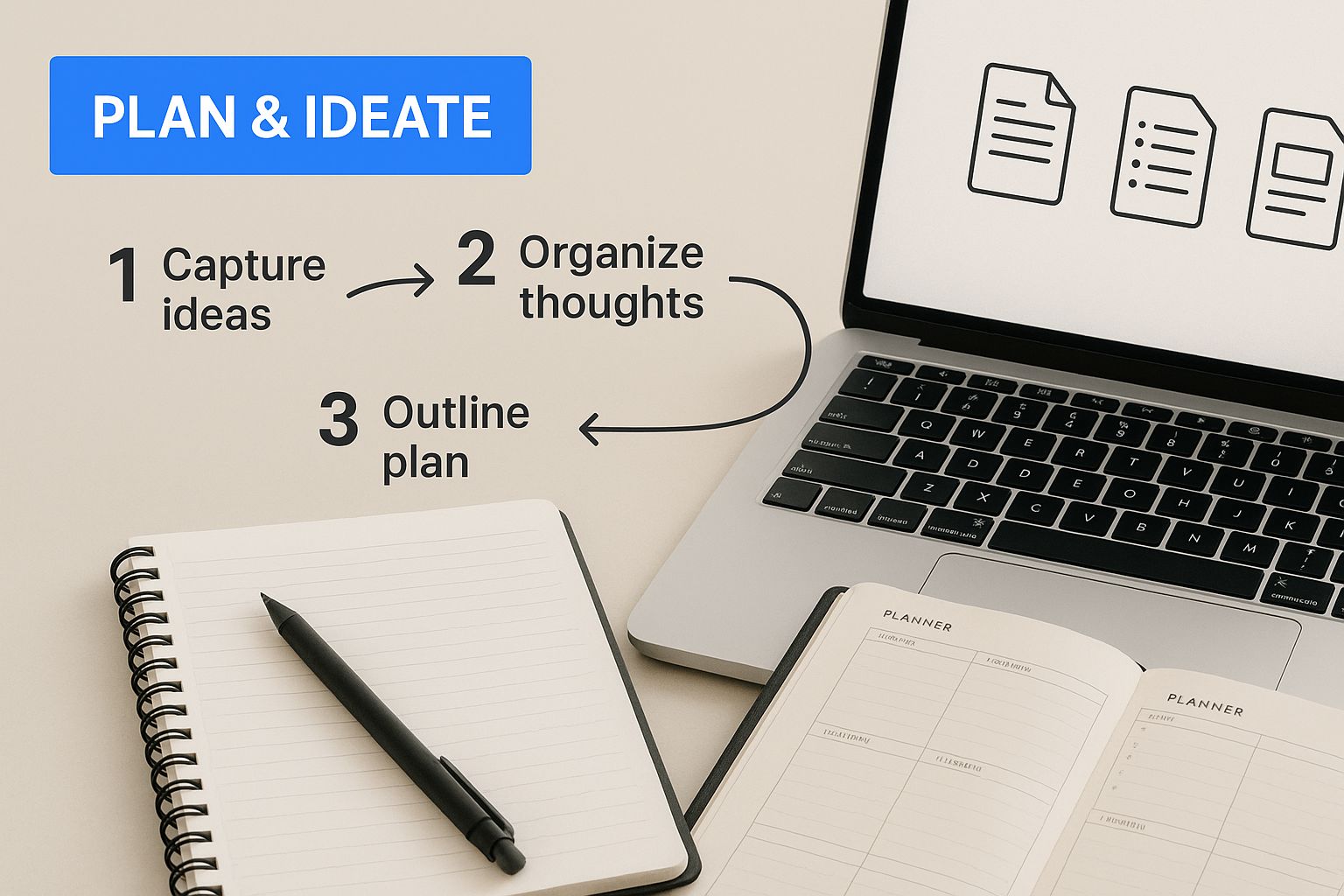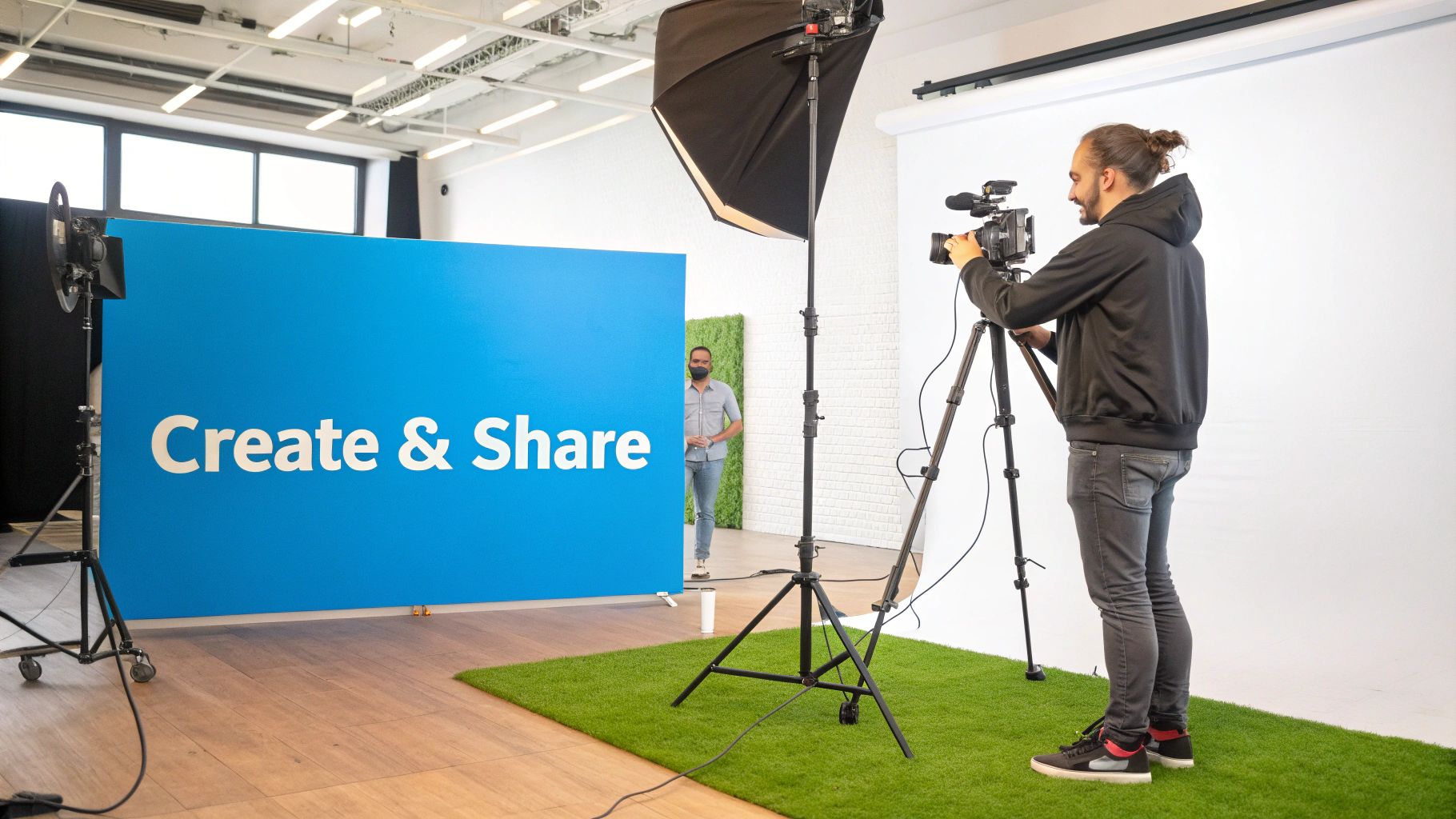Your Guide to a Content Marketing Strategy

A solid content marketing strategy is your detailed game plan for how you create and use content to hit specific business goals. It’s what separates random posts and articles from a cohesive, growth-oriented system that turns your creative work into real, measurable results.
Why Your Business Needs a Documented Content Strategy

Let's get one thing straight: a strategy isn't just a "nice-to-have." It's the absolute, non-negotiable core of any sustainable growth. Pushing out content without a plan is like building a house without a blueprint. You might end up with something, but it probably won’t be sturdy, functional, or efficient.
A documented strategy gives you a clear roadmap, transforming your content from scattered marketing efforts into a predictable engine for generating leads and building brand authority. This is becoming standard practice, with nearly 84% of companies worldwide now having a content marketing strategy to keep up. Without one, you’re just letting competitors who are planning their engagement get ahead.
Align Your Team and Conserve Resources
One of the biggest wins from a solid strategy is simple: team alignment. When your writers, designers, and marketers are all on the same page and understand the bigger goals, everyone works in sync. This simple change cuts out a ton of wasted effort and saves precious resources like time and money.
Instead of your team just guessing what to create next, they have a clear directive. This even extends to how you create content. For instance, knowing how new technologies fit into a structured plan is key, which is why we explored whether AI-generated content can rank on Google and how to approach it strategically.
A well-defined strategy ensures every single blog post, video, and social media update serves a specific purpose. It contributes directly to your business objectives instead of just filling a slot on the content calendar.
Build Authority and Drive Measurable Outcomes
When you consistently put out high-quality, relevant content, you start to build a reputation as a thought leader. A documented plan is what ensures your content always provides genuine value, which in turn builds trust and keeps your audience coming back for more.
To get a much deeper look at all the moving parts, from development to execution, this comprehensive resource can help you Master Your Content Marketing Strategy for Growth. At the end of the day, a strategy is what turns your creative ideas into business outcomes you can actually measure.
To put it all together, a modern content strategy rests on a few essential pillars. Here’s a quick-glance table that breaks down the core components.
Core Components of a Modern Content Strategy
| Component | Objective | Key Action |
|---|---|---|
| Audience Personas | Understand who you're talking to. | Develop detailed profiles of your ideal customers. |
| Topic Clusters & Pillars | Establish topical authority and structure. | Identify core themes and create supporting content. |
| Content Creation | Produce high-value, relevant assets. | Set up a workflow for writing, design, and video. |
| Distribution Channels | Get content in front of the right eyes. | Select and optimize channels like SEO, email, and social. |
| Performance Metrics | Measure what's working and what's not. | Track KPIs like traffic, engagement, and conversions. |
This table serves as a great checklist to make sure you're covering all your bases as you build or refine your plan. Each component is critical for creating a system that not only attracts an audience but also converts them into loyal customers.
First Things First: Who Are You Talking To, and Why?
A content marketing strategy that actually works is built on two simple, yet powerful, ideas: knowing exactly who you're talking to and what you're trying to accomplish. If you skip this part, you're just creating content in a vacuum, throwing things at the wall and hoping something sticks.
Trust me, great content always starts with a deep, almost obsessive, understanding of your audience.
This isn't just about surface-level demographics like age or where they live. You need to get into their heads. This means building out detailed audience personas that capture their real-world headaches, what drives them, and even the exact words they use to describe their problems. What's keeping them up at night? What are they trying to achieve in their job or life? Before you write a single word, you have to nail down how to find your target audience by digging into these messy, human questions.
Turn Audience Knowledge into Real Goals
Once you have a crystal-clear picture of your ideal customer, the next step is to connect that knowledge to real business objectives. Vague goals like "get more traffic" or "boost engagement" just don't cut it. They're not actionable. Your goals need to be specific, measurable, and directly linked to what your audience actually needs.
This is where the SMART framework (Specific, Measurable, Achievable, Relevant, Time-bound) is your best friend. It’s a classic for a reason.
A well-defined goal transforms your content from just another blog post into a strategic business asset. Every single piece of content should have a clear job to do and a way to measure if it did it.
Think about the difference. A weak strategy is full of fuzzy wishes. A powerful one operates on precise targets.
For example:
- Weak Goal: "We want more leads."
- SMART Goal: "Increase marketing qualified leads (MQLs) from our organic blog traffic by 20% in the next six months. We'll do this by creating content that directly solves our primary persona's top three pain points."
See the difference? That level of focus means every article, video, or social post you publish has a purpose. It gives you a clear benchmark for success and lets you prove the real return on your content investment. When you align your audience's needs with sharp, data-backed goals, you create a feedback loop that fuels constant improvement and shows everyone the value of what you're doing.
Building Your Content Creation Engine
Alright, with your goals set and your audience in mind, it's time to get into the nuts and bolts. We need to build the operational heart of your content marketing: the content creation engine. This is the system that turns your ideas into valuable, high-impact assets, not just once, but consistently. We're moving beyond random acts of content and building a predictable, sustainable workflow.
The first thing to tackle is shifting from pure guesswork to a structured process for brainstorming and actually validating those ideas. You'll want to combine solid keyword research, a deep dive into what your competitors are up to, and—most importantly—direct feedback from your customers. This is how you generate topic ideas that already have a built-in audience waiting for them.
A fantastic framework for this is the content pillar and topic cluster model. It’s a game-changer. You start with a broad, comprehensive "pillar" piece on a core subject, like an ultimate guide. Then, you create a series of more specific "cluster" articles that all link back to that main pillar. This structure does wonders for your SEO by signaling your topical authority to search engines.
From Ideas to a Realistic Calendar
Once you have a backlog of solid, validated topics, you hit the next big challenge: creating a content calendar that you can actually stick to. This is where so many strategies fall apart. A good calendar isn't just a list of wishes; it balances your ambition with your actual resources. It clearly maps out what gets created, by whom, and when.
This is also the perfect moment to nail down a clear brand style guide. This document is your secret weapon for consistency, ensuring every piece of content maintains the same voice, tone, and visual identity, no matter who on your team creates it.
Here’s a look at how those initial planning stages come together.
As you can see, the strategic planning and ideation are the foundational desk work that has to happen before you even think about hitting "publish."
A documented workflow, from brainstorming ideas to managing the calendar, is what separates professional content operations from amateur ones. It’s what allows you to scale, whether you’re a small business just starting out or a large enterprise with a full team.
We're also seeing a shift in content marketing budgets and the tools we use, with technology playing a much bigger role. Recent research shows that 46% of B2B marketers expect their content budgets to grow, and a whopping 61% are putting a major focus on video. As tools and trends evolve, you can find more great stats like these from the Content Marketing Institute.
Using AI can definitely help you produce content at scale, but the final output absolutely must feel authentic. Our guide on how to humanize AI content walks you through the steps to maintain that crucial, genuine connection with your audience.
Getting Your Content Seen: A Guide to Distribution and Promotion
You can craft the most brilliant, insightful piece of content the world has ever seen, but if it just sits on your blog gathering digital dust, it’s all for nothing. This is where a smart distribution and promotion plan shifts from a "nice-to-have" to an absolute necessity.
The image above really nails this point. It breaks down the different media types, showing that getting your content out there is just as important as creating it in the first place. Success isn't just about what you write; it's about how you get it in front of the right people.
Owned, Earned, and Paid: Your Distribution Toolkit
Long gone are the days of just hitting "publish" and tweeting a link. A modern strategy requires an integrated approach that pulls from a few different playbooks.
-
Owned Media: This is your home turf—the channels you control completely. Think of your blog, your website, and, most importantly, your email newsletter. These are foundational for building a direct line to your audience.
-
Earned Media: This is the digital equivalent of word-of-mouth. It’s the traffic you earn when others share your work. This includes guest posts on respected industry blogs, mentions in the media, glowing reviews, and organic social media shares.
-
Paid Media: Sometimes, you need to give your content a nudge. This involves paying to place your content in front of a highly targeted audience through channels like social media ads, search engine marketing (SEM), or sponsored content.
Amplify Your Reach and Squeeze Every Drop of ROI
The real magic happens when you choose the right channels for your specific content and audience. A dense, data-heavy B2B whitepaper? That’s perfect for a targeted email campaign and some carefully placed LinkedIn ads. A fun, visual infographic? Unleash it on Pinterest and Instagram and watch it fly.
This is also where content repurposing becomes your secret weapon. One great blog post doesn't have to stay a blog post. It can be the seed for an entire ecosystem of content.
That single, deeply-researched article can be atomized into an eye-catching infographic, a short video script, a podcast episode, a slide deck, and a full week's worth of social media updates. This is how you maximize the return on every ounce of creative energy.
As you build out your plan, it’s worth remembering the scale of this industry. The global content marketing market is on track to hit $2 trillion by 2032, a huge jump from $413.2 billion in 2022. This explosive growth means a sophisticated distribution strategy isn't just an advantage—it's essential for survival.
Even if you're using AI to help create or repurpose content, making sure each piece feels fresh and authentic is non-negotiable. For some practical tips on this, take a look at our guide on how to avoid AI detection in writing to keep your messaging genuine across every channel.
How to Measure Content Performance and ROI
Let's be honest: content marketing without measurement is just an expensive hobby. If you want to prove its value and actually make smart, data-driven decisions, you have to track the key performance indicators (KPIs) that really matter.
This isn't about chasing vanity metrics like page views. It’s about connecting your content directly to tangible business results.
Your first move should be building a simple, effective dashboard to see what’s working and what’s not. A tool like Google Analytics is perfect for this. It gives you a clear view of the entire customer journey, from the first time someone discovers your brand all the way to a sale.
Connecting Metrics to Funnel Stages
Different metrics tell different parts of the story, depending on where your audience is in their journey. A solid measurement plan keeps an eye on performance across every stage, giving you a complete picture of your impact.
-
Top-Funnel (Awareness): At this stage, you’re just trying to get on people's radar. You're looking at reach and initial engagement. The key metrics here are things like organic traffic, keyword rankings, social media reach, and backlinks. These numbers tell you how many new people are discovering your brand through your content.
-
Mid-Funnel (Consideration): Now you're focused on nurturing that initial interest and turning visitors into leads. You'll want to track metrics like new email subscribers, time on page, click-through rates (CTR) on your internal links, and content downloads (think ebooks or whitepapers).
-
Bottom-Funnel (Decision): This is where your content starts making you money. The most critical KPIs here are lead-to-customer conversion rates, demo requests, and sales attributed to specific pieces of content. This is how you ultimately analyze ROI on your content marketing and justify your budget.
The real goal here is to uncover actionable insights. For example, if a blog post gets a ton of traffic but generates zero leads, your call-to-action is probably weak. If an ebook gets lots of downloads but very few of those leads convert to customers, your follow-up email sequence might need a tune-up.
This data is your roadmap. It tells you exactly where to double down and what strategies to ditch.
As you scale up your content creation, it's also vital to make sure everything still feels authentic and human. To learn more about maintaining that balance, check out our guide on how to use AI without plagiarizing. It’ll help ensure your data-informed strategy always sounds genuine.
Answering Your Content Strategy Questions
Even with a perfect plan on paper, questions always come up once you start executing. It's totally normal. Here are some of the most common ones I hear from teams as they get their content marketing off the ground.
How Long Until We See Results?
This is the million-dollar question, isn't it? The honest-to-goodness answer is: it depends. But as a general rule, you need to give your strategy at least six to nine months to really start humming. Think about it—SEO-driven content isn't an overnight success. It takes time for Google to find, crawl, index, and eventually trust your pages enough to rank them.
You’ll see some early wins, for sure. A little bump in social engagement or a slow-and-steady climb in organic traffic might show up in three or four months. But the real meat—the significant lead generation and measurable ROI—comes from playing the long game. It's all about building momentum, so patience is your best friend here.
What's a Realistic Content Budget for a Small Business?
You don't need to break the bank to get started. For a small business, the smartest move is to pour your resources into just one or two channels where you know your audience lives.
Don't try to be everywhere at once. Find one channel and completely own it. If your audience is all over LinkedIn, for example, put your energy into creating killer articles and videos for that platform before you even think about expanding. A focused attack will always give you a better return on a tight budget.
A lean but mean strategy could be as simple as publishing one really solid blog post a week, sharing it with your email list, and then slicing and dicing it for social media. The key is consistency and quality, not just cranking out a ton of content. Once you start seeing some traction, you can smartly reinvest those wins back into your content machine.
Can We Actually Do This with a Small Team?
Absolutely. I've seen one-person marketing departments run incredibly effective content strategies. The secret is to be brutally realistic and ruthlessly efficient with your time.
Focus on creating one big "pillar" piece of content each month—maybe an in-depth guide or a comprehensive webinar. Then, spend the rest of your time breaking that single asset down into smaller, bite-sized pieces. One guide can become 10 social posts, a few email newsletters, a short video script, and a handful of graphics.
This "create once, distribute many" model lets a tiny team generate a huge amount of promotional material from a single chunk of creative work. It's the best way to maximize your reach without burning out.
Ready to create high-quality, authentic content without the extra work? Word Spinner is your all-in-one AI writing platform to humanize, rewrite, and generate engaging text that bypasses AI detectors. Start your free trial today at https://word-spinner.com.

